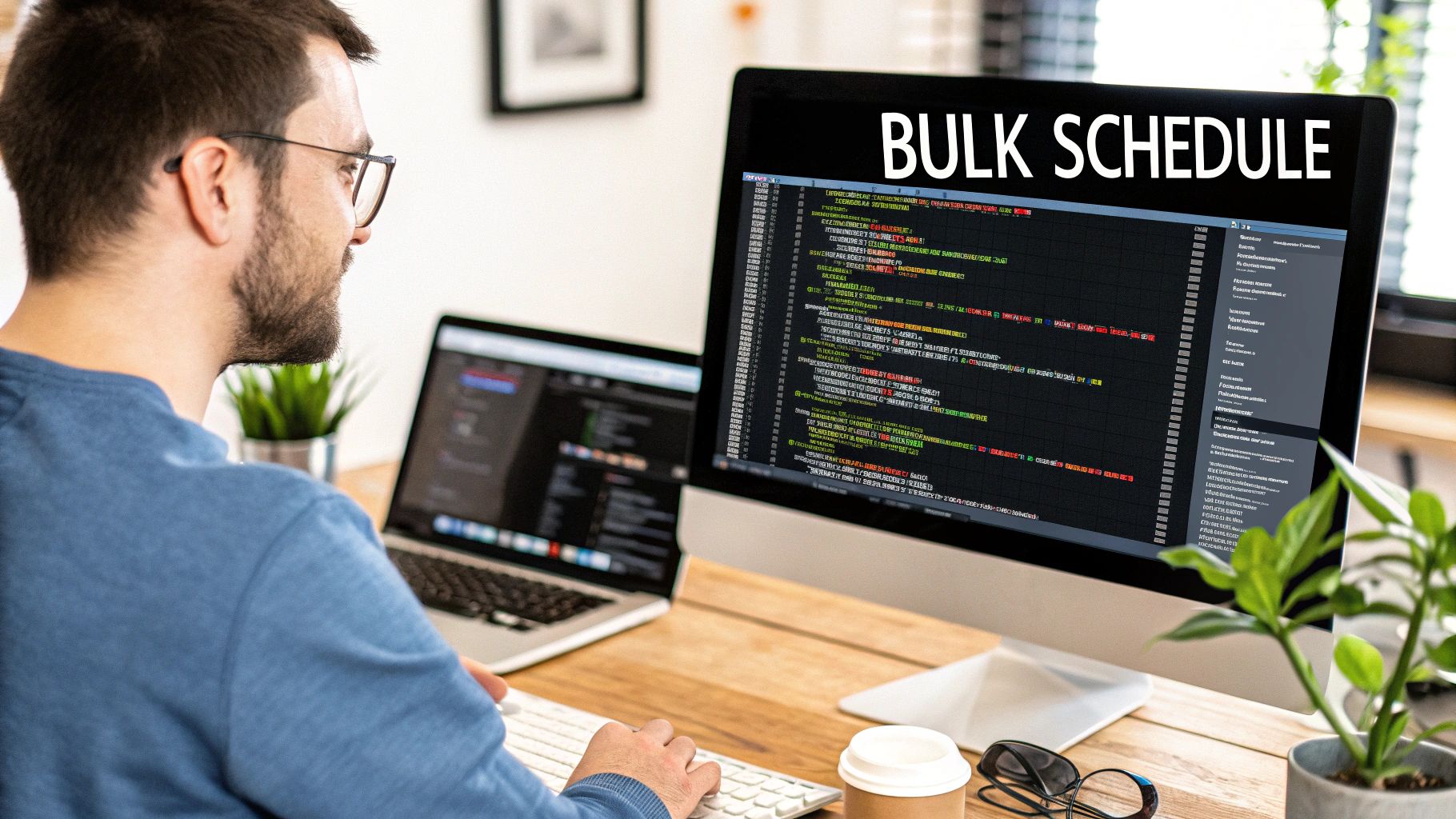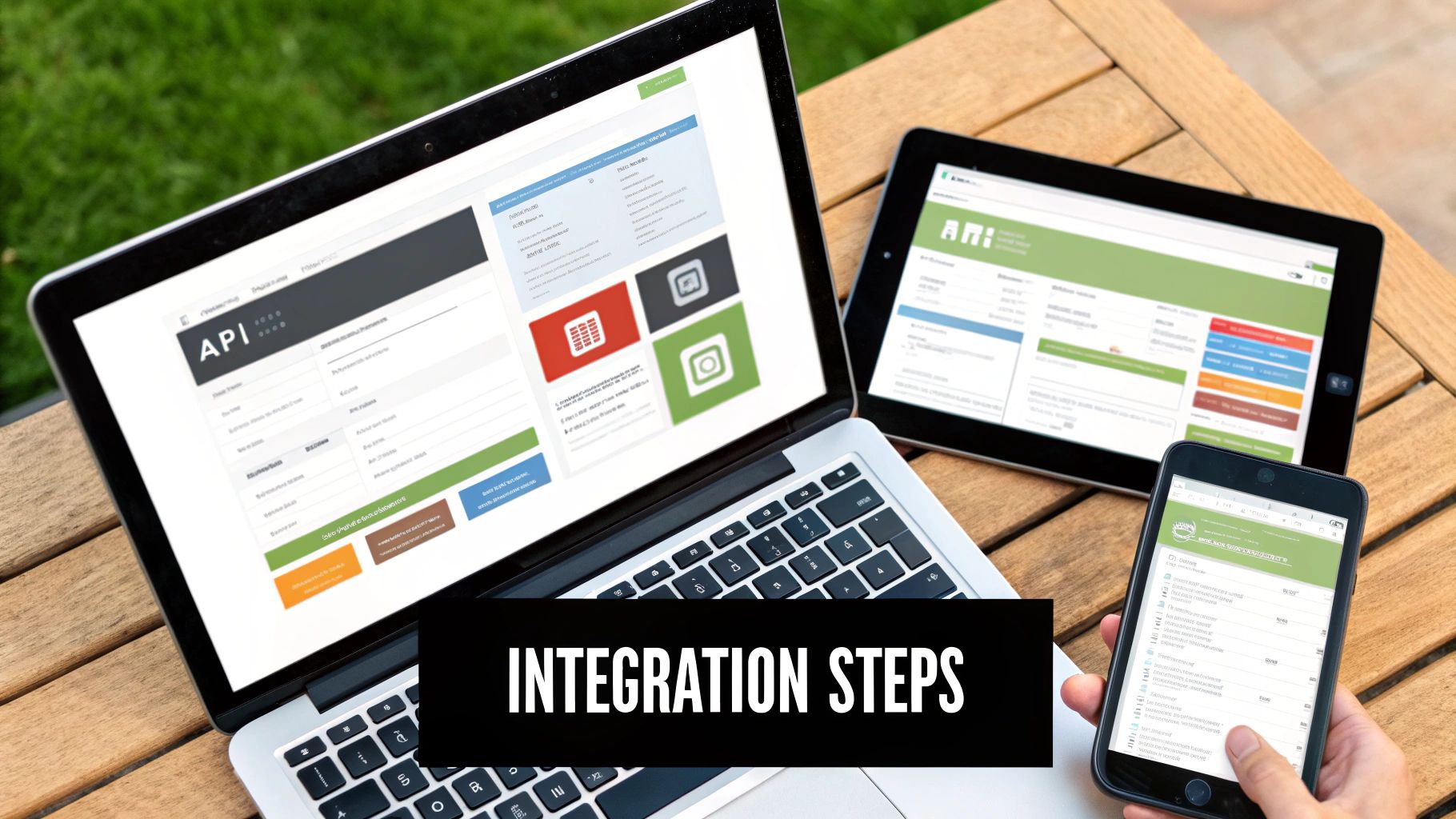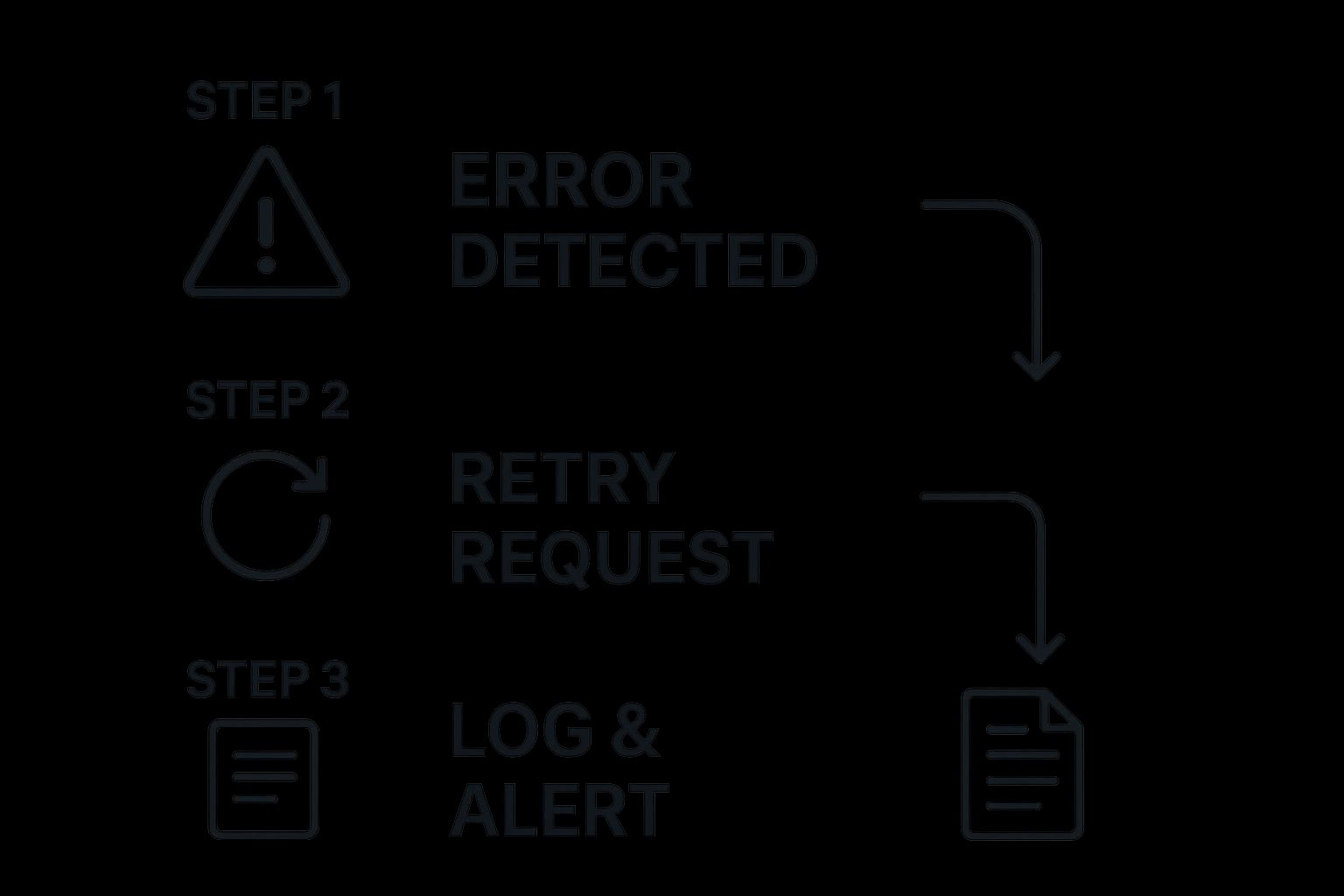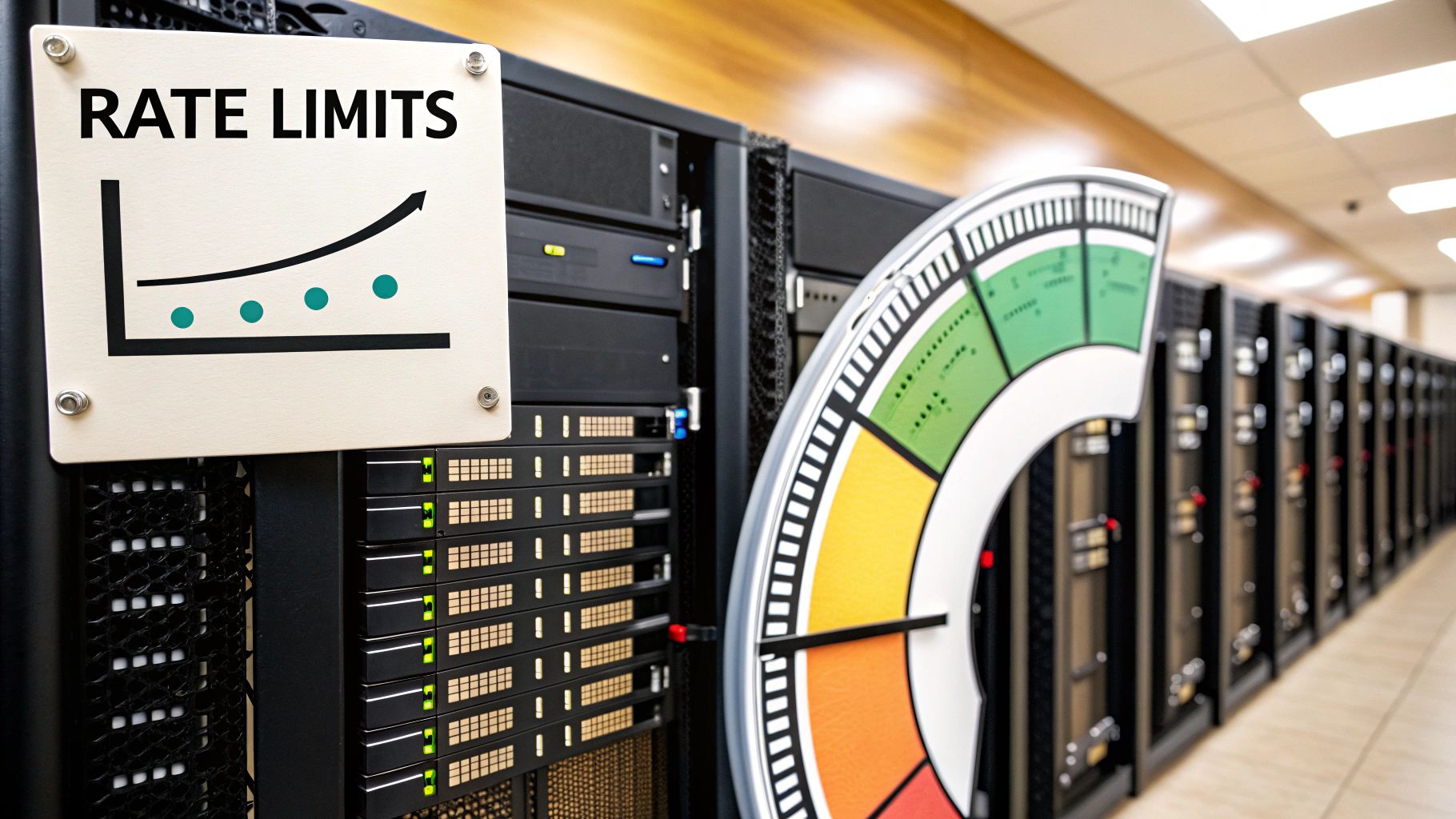At its core, a bulk schedule social posts API is an interface that lets developers schedule hundreds, or even thousands, of social media posts across different platforms with a single command. It’s the engine that powers social media management for agencies juggling dozens of client accounts and big brands with massive content calendars.
Think of it as moving beyond the click-and-schedule routine of a standard dashboard. This is about automation on a whole new level.
Why You Need a Bulk Schedule Social Posts API

Let's get past the idea of just scheduling one post at a time. Using a bulk scheduling API is a strategic shift from tedious manual work to programmatic, scalable automation that solves real-world problems.
For a marketing agency, this could mean scheduling an entire month of content for 50 different clients with a single script. For an e-commerce brand, it could be a system that automatically queues up new product announcements for Instagram and Facebook the second they're added to the inventory.
That's the kind of power an API gives you over a standard dashboard.
Unlocking True Scalability and Efficiency
The real magic of a bulk schedule social posts API is the raw scalability and efficiency it brings to the table—something manual processes just can't touch. It lets you build completely custom workflows that fit your exact operational needs.
This shift is crucial when you consider the sheer volume of online activity. People worldwide spend over 14 billion hours on social media daily, according to research from Talkwalker. This forces marketers to be incredibly strategic about post timing and frequency just to get noticed.
This is where programmatic control becomes a game-changer. Instead of being locked into a user interface, you can build systems that:
- Pull content directly from a database, a Google Sheet, or a CMS.
- Automatically reformat posts for different platforms, adjusting for character limits or image ratios on the fly.
- Weave social media scheduling into your broader marketing automation sequences.
By removing the UI as a bottleneck, an API lets you treat your content calendar as code. It becomes versionable, repeatable, and infinitely scalable.
This programmatic approach is essential for anyone serious about managing social media at scale. It transforms a repetitive, soul-crushing task into an efficient, automated process that just works.
To get a better handle on how these systems operate, check out our deep dive on the core concepts of a social media scheduling API. Understanding the fundamentals is key to building social media tools that are both powerful and reliable.
Understanding the Core API Endpoints
Before you jump in and start writing code for a bulk schedule social posts API, you need to get familiar with the core building blocks you'll be working with. I like to think of API endpoints as specific doors on a server. You knock on one door to get authenticated, another to upload a photo, and a final one to schedule the actual post.
Your script’s very first conversation with the API will always be about authentication. This is where the API verifies your identity—usually with a simple API key or a more involved protocol like OAuth 2.0—and gives you the green light to start making requests.
The Main Endpoints You'll Use
Once you're authenticated, you'll work with a predictable sequence of endpoints to get your content queued up. The exact naming might differ slightly from one API to another, but their jobs are almost always the same.
- Social Accounts Endpoint: This is your starting point. You'll call this to get a list of all the social media profiles you've connected. The key here is grabbing the unique ID for each profile, which you'll need to tell the API exactly where to send each post.
- Media Upload Endpoint: Got images or videos? You can't just bundle the file with your text. You first have to upload the media to this endpoint. It processes the file and hands back a unique
media_idthat you'll use in the next step. - Post Scheduling Endpoint: This is the main event. You'll send a request containing your text, the
media_id(if you have one), and the target social account ID. You'll also include the specific time you want the post to go live.
To give you a clearer picture, here's a quick rundown of the key players in this process.
Key API Endpoints for Bulk Scheduling
This table summarizes the essential endpoints you'll interact with during the bulk scheduling workflow and what each one does.
| Endpoint | HTTP Method | Primary Function |
|---|---|---|
| Authentication | POST | Verifies your identity and provides an access token or key. |
| Social Accounts | GET | Fetches a list of all connected social media profiles and their unique IDs. |
| Media Upload | POST | Uploads an image or video and returns a unique media_id. |
| Post Scheduling | POST | Schedules a post with text, media, and a publication time to a specific account. |
Having these endpoints separated ensures a clean, predictable workflow for every post you schedule.
A common mistake I see developers make is trying to cram a huge batch of posts into a single API call. Most systems are built to handle posts individually or in small, controlled batches. This helps manage server load and gives you much clearer feedback if a specific post fails.
This sequence is designed to be efficient and reliable. For a deeper dive into the mechanics, our guide on what an API endpoint is breaks these concepts down even further.
One last thing to keep in mind is the API’s rate limits—the number of requests you can make in a set period. If you go over, you'll get temporarily blocked. Good code anticipates this by building in small delays or gracefully handling the 429 Too Many Requests error when it pops up.
Setting Up Your Development Environment

Alright, let's get our hands dirty. Before you can harness the power of a bulk schedule social posts API, you need to get your local workspace in order. Think of this as laying the foundation—a solid setup now prevents headaches later and keeps your sensitive credentials locked down tight from day one.
Your first move is picking a programming language. Honestly, you can't go wrong with Python. Its clean syntax combined with the fantastic requests library makes firing off HTTP calls a breeze. If you're more of a JavaScript person, Node.js is another killer choice, especially with libraries like axios that handle asynchronous tasks beautifully, which is basically the bread and butter of API workflows.
Keeping Your API Credentials Safe
Before you write a single line of code that talks to the API, you'll need your credentials. You’ll typically grab these from the API provider's developer portal by registering your app. They'll hand you an API key and a secret—treat these like the keys to your kingdom.
I can't stress this enough: never, ever hardcode your API keys directly into your script. It's a massive security hole, especially if you're pushing your code to a public repository on Git. Seriously, don't do it.
The right way to handle this is by using environment variables. This technique keeps your secret keys separate from your actual code, allowing your application to use them without exposing them to the world.
Here’s a quick checklist of the tools you'll need to get started:
- Language: We recommend Python or Node.js.
- HTTP Library: For Python, grab
requests(pip install requests). For Node.js, you'll wantaxios(npm install axios). - Environment Variables: Use a
.envfile along with a library likepython-dotenvor thedotenvpackage for Node.js. This is the pro move for managing API keys securely.
Once you've got these pieces in place, you're all set to authenticate and start making your first API calls. And as you get deeper into the project, keeping your API organized is key. A good resource like the ultimate guide to API documentation generation can be a lifesaver for maintaining clarity and structure.
Scheduling Your First Bulk Upload from a CSV
Alright, let's get our hands dirty. It’s time to build a script that can read a bunch of posts from a simple CSV file and schedule them all at once using a bulk schedule social posts API. This is the go-to method for anyone managing a serious content calendar. It lets you plan everything out in a familiar spreadsheet before a single line of code runs.
The basic idea is pretty simple. Your script will perform three main jobs:
- Read the data from your CSV file.
- Convert each row into the JSON format the API needs.
- Loop through every post and send it off to be scheduled.
Trust me, this is way more efficient than clicking "schedule" a hundred times for a big campaign.
Structuring Your CSV Data
A CSV (Comma-Separated Values) file is just a plain text file that organizes data like a spreadsheet. Your script will go through this file, line by line, with each row representing a future social media post.
Here’s what that looks like in practice—a simple CSV on the left and how it gets interpreted as a table on the right.

This clean structure makes it a breeze for a script to pull out specific details for each post, like the caption, a link, and when it should go live. Getting comfortable with automating content creation from structured data is a huge unlock. If you want to dive deeper into a similar concept, check out this great tutorial on programmatically creating pages from a CSV file.
For our purposes, a good CSV for bulk scheduling would have columns like these:
account_id: The unique ID for the social media profile you're posting to.post_text: The actual content or caption of your post.image_url: A direct URL to any image you want to include.scheduled_at: The exact date and time for publishing, usually in ISO 8601 format.
This organized approach is the foundation of any reliable automation. You need to know that your data is clean and your API is dependable. Speaking of dependability, an analysis of over 10 million API calls found that the Instagram profile API endpoint handled 4.31 million calls with an impressive 99.57% success rate. That’s the kind of stability you want when you’re building a workflow like this.
Handling Errors and Retries Robustly
So, what happens when one post in your batch of 100 fails to schedule? A well-built script doesn't just crash and burn. It needs to handle that failure gracefully and keep going. This is where solid error handling and retry logic are non-negotiable.
The goal isn't to prevent every possible error—that's impossible. The goal is to build a system that anticipates failures, logs them for review, and continues its work without bringing the entire batch to a halt.
When an API request fails, your script should immediately log the error along with the specific post data that caused it. For temporary problems like a network hiccup, it's smart to implement an exponential backoff strategy. This means the script waits a bit before trying again, and waits a little longer after each subsequent failure.
This simple flow chart breaks down how to handle errors effectively during bulk API calls.

It’s all about having a system: detect the problem, retry if it makes sense, and log everything. This makes your script far more resilient and gives you a clear trail for debugging when things go wrong.
Advanced Techniques and Common Pitfalls to Avoid

So, you've mastered scheduling from a CSV. That's a great start, but now it's time to build smarter, more resilient automation that doesn't rely on static files.
Think bigger. Imagine your script programmatically creating posts by pulling directly from a product database, an RSS feed, or even a live event stream. This moves you from simple scheduling to dynamic, real-time content generation.
Another powerful upgrade is to ditch constant API polling for webhooks. Instead of repeatedly asking the API "is it done yet?", webhooks let the API tell you the moment a post goes live or if it fails. It’s a far more elegant and efficient way to monitor your scheduled content without wasting resources.
Sidestepping Common Mistakes
Even the most brilliant script can trip up if it ignores the rules of the road. Every social network has its own unique quirks you absolutely have to account for.
We're talking about things like:
- Character limits (Hello, X.com)
- Specific image aspect ratios
- Maximum video lengths and file sizes
Your code needs to validate all this before you even think about hitting the bulk schedule social posts API.
The social media world is massive, with 5.24 billion active users. A platform like Instagram alone serves over 2 billion of them. Operating at that kind of scale means you have to play by their rules. You can dig into more stats about the global user base on Backlinko.
One of the most common—and disruptive—pitfalls I see is mishandling API rate limits. Sending too many requests too quickly is a surefire way to get your application temporarily blocked, bringing your entire workflow to a screeching halt.
Gracefully managing these limits isn't just a suggestion; it's a requirement for reliable automation. This means building logic into your script to slow down requests as you approach a platform's limit. For a deeper dive on this, check out our guide on API rate limit best practices.
And a final pro-tip: always, always account for time zones. Scheduling a post for 9 AM means nothing if you don't specify where. Getting this right ensures your content lands in front of your global audience at the perfect local time.
Answering Your Top API Questions
When you start digging into a bulk schedule social posts API, a few questions always come to the surface. I've seen them come up time and again from developers, and getting them answered upfront is the key to building a solid, reliable integration.
Can One API Really Handle All Social Platforms?
This is usually the first question people ask. Can a single API talk to Instagram, X.com, LinkedIn, and everything else? The short answer is no, not directly. At least, not without a whole lot of pain.
Most bulk scheduling APIs are actually from third-party services. These services have already done the grueling work of integrating with the official APIs for each social network.
You get to use their single, unified API, and they handle the messy backend—the different rules, the unique authentication methods, and the constantly changing rate limits for each platform. It's a massive shortcut that saves you from building and maintaining half a dozen separate, brittle integrations.
How Do Bulk Media Uploads Actually Work?
Another big one is how to handle images and videos. If you tried to send a bunch of large media files with every single post request in a bulk job, it would be incredibly slow and inefficient. Your whole system would grind to a halt.
Instead, smart APIs split this process into two steps to keep things snappy:
- Upload the Media First: You send your image or video to a dedicated media endpoint. The API chews on the file for a moment and then hands you back a unique
media_id. - Schedule with the ID: Now, when you create the post scheduling request, you just include that lightweight
media_idinstead of the whole file. The API service knows exactly which media to attach when it’s time to publish.
What Are the Most Common API Errors I'll Hit?
Finally, what should you prepare for? From what I've seen, most errors fall into three main buckets.
First up are authentication errors (401/403 codes), which almost always mean you've got an invalid API key. Next are validation errors (400/422 codes). These pop up when the post data is messed up—maybe a caption is too long for X.com or a link format is wrong.
Lastly, you'll see rate limit errors (429 codes) if you're sending too many requests too fast. Good, defensive code doesn't just crash on these; it anticipates them, logs the issue, and flags that specific post so a human can take a look.
Ready to stop juggling multiple platform APIs? With Late, you can schedule posts across seven major social networks with a single, reliable integration. Start building for free with our API today.